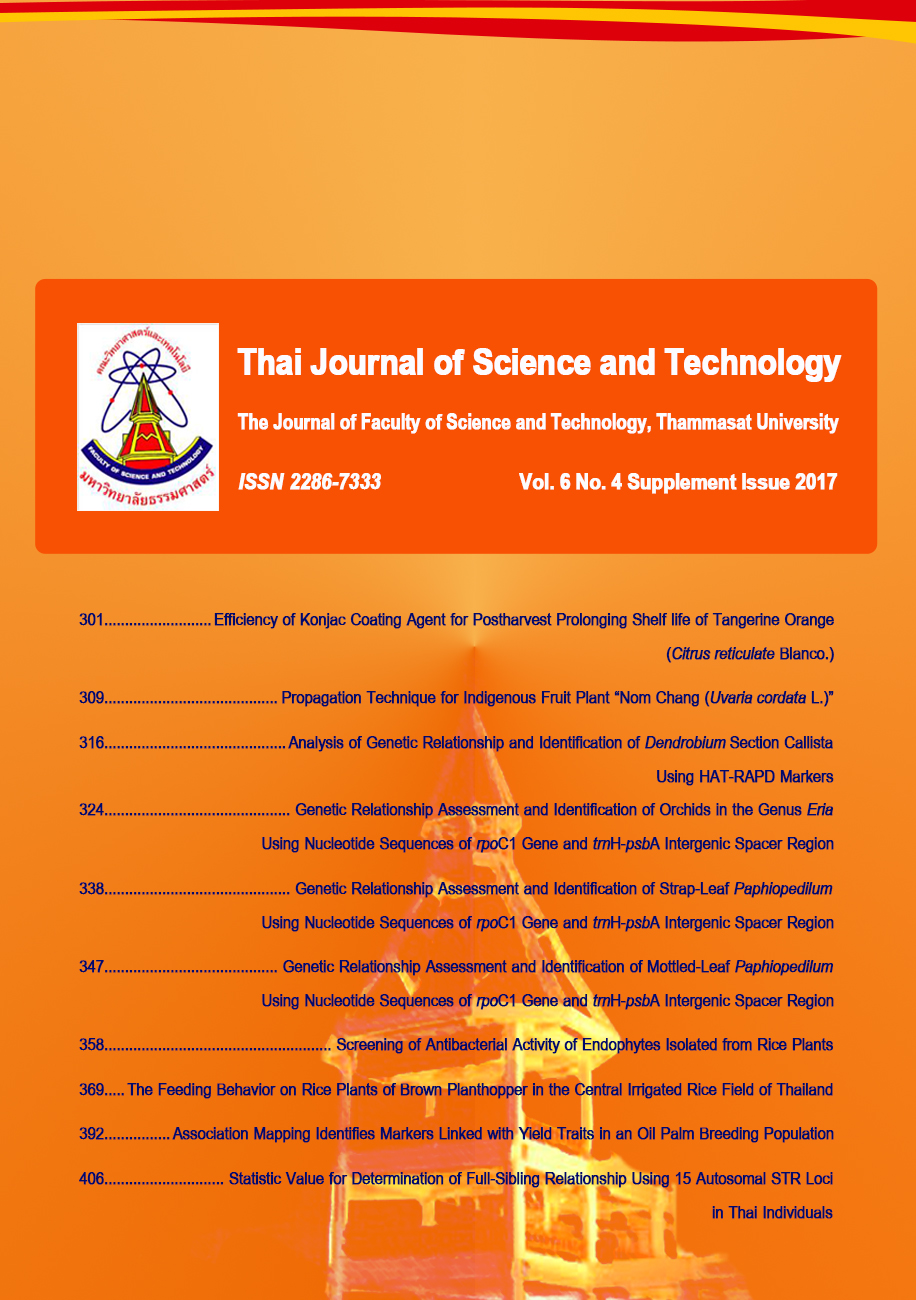การขยายพันธุ์ผลไม้พื้นบ้าน “นมช้าง”
Main Article Content
Abstract
บทคัดย่อ
นมช้างเป็นผลไม้พื้นบ้านในวงศ์กระดังงาที่พบกระจายตัวอยู่ทั่วไปในป่าของประเทศไทย งานวิจัยนี้เป็นการศึกษาลักษณะทางสัณฐานวิทยาและสรีรวิทยาและพัฒนาเทคโนโลยีการขยายพันธุ์ ซึ่งึ่งนโลยีการขยายพันธุ์ กrt Universityตรศาสตร์ทดลองที่สถาบันวิจัยวิทยาศาสตร์และเทคโนโลยีแห่งประเทศไทย (วว.) เทคโนธานี ตำบลคลองห้า อำเภอคลองหลวง จังหวัดปทุมธานี ตั้งแต่ปี พ.ศ. 2558 ถึงปี พ.ศ. 2560 พบว่านมช้างเป็นพืชที่มีทรงพุ่มโปร่ง ลำต้นกึ่งเลื้อยหรือเลื้อยพาดไปกับต้นไม้อื่น เปลือกต้นสีน้ำตาล กิ่งแตกแบบสลับที่มีปลายกิ่งชูขึ้นหรือเลื้อยพาด ใบสีเขียวเข้มรูปหอก หนา เรียบ เป็นมันทั้งสองด้าน ปลายยอดอ่อนมีขนปกคลุม ก้านใบค่อนข้างสั้น ดอกเดี่ยวสีแดงเลือดนกมีโคนกลีบสีเหลืองอ่อน กลีบดอกหนา ออกที่ปลายกิ่งหรือตรงข้ามใบ มีกลิ่นหอมอ่อน ๆ ผลเป็นกลุ่มที่มีผลย่อย 3-30 ผล รูปทรงกระบอก ผลอ่อนสีเขียวซึ่งจะเปลี่ยนเป็นสีเหลืองเมื่อเริ่มแก่ และเปลี่ยนเป็นสีม่วงเข้มเมื่อผลสุก การขยายพันธุ์ต้นนมช้างที่เหมาะสม คือ การเสียบยอดแบบเสียบข้าง เนื่องจากมีอัตราการเสียบติดมากกว่าแบบเสียบลิ่ม แต่การเสียบยอดทั้ง 2 แบบ ส่งผลต่อการเจริญเติบโตของกิ่งพันธุ์ไม่แตกต่างกัน ส่วนการใช้ต้นตอต่างชนิดกันไม่มีผลต่อการเสียบติดในช่วงแรก แต่มีผลต่อการเจริญเติบโตหลังการเสียบติดในช่วงอายุ 5 เดือน เป็นต้นไป โดยการใช้ต้นตอนมช้างซึ่งเป็นพืชชนิดเดียวกันกับกิ่งพันธุ์ส่งผลให้ยอดของกิ่งพันธุ์นมช้างมีการเจริญเติบโตดีกว่าการใช้ต้นตอกล้วยหมูสัง และต้นตอพีพวนน้อย ตามลำดับ
คำสำคัญ : ต้นนมช้าง; เสียบยอดแบบเสียบข้าง; เสียบยอดแบบเสียบลิ่ม
Abstract
Nom Chang (Uvaria cordata (Dunal) Alston), a member of family Annonaceae, is an indigenous fruit plant habitually distributed in tropical rain forest, dry evergreen forest, dipterocarp forest, and mixed deciduous forest in Thailand. This study illustrated its morphology and physiology together with optimal propagation technique for Nom Chang plantation. All experiments were conducted at Thailand Institute of Scientific and Technological Research (TISTR), Khlong Ha, Khlong Luang, Pathum Thani during 2015 to 2017. The morphological and physiological observations reveled that Nom Chang was a climbing plant with airy canopy. It had brown bark, zig-zag twigs with upright or creep tips, thick deep green spear-shaped glossy leaves with short stalk, and hairy shoots. Its flowers were dark red and their thick petals were pale yellow at the base. The mild scented flowers were originated either at the tip of each twig or oppose the leaves. The fruits of Nom Chang were aggregate with 3-30 fruits in each bunch. A shape of each fruit was cylinder, and its color was green when it was immature following by yellow once being mature and turned to deep purple when being ripen. Nom Chang was able to be propagated by grafting and it was found that side veneer grafting was better than cleft grafting in terms of survival rate of the scion. However, both grafting methods provided no differences on the scions’ growth. The selection of proper rootstock showed that rootstock of Nom Chang was the best in terms of noticeably promoting its scion growth after 5 weeks of grafting followed by Gluay Moosang (U. grandiflora L.) and Pipuan Noi (U. rufa L.).
Keywords: Uvaria cordata L.; side veneer grafting; cleft grafting
Article Details
บทความที่ได้รับการตีพิมพ์เป็นลิขสิทธิ์ของคณะวิทยาศาสตร์และเทคโนโลยี มหาวิทยาลัยธรรมศาสตร์ ข้อความที่ปรากฏในแต่ละเรื่องของวารสารเล่มนี้เป็นเพียงความเห็นส่วนตัวของผู้เขียน ไม่มีความเกี่ยวข้องกับคณะวิทยาศาสตร์และเทคโนโลยี หรือคณาจารย์ท่านอื่นในมหาวิทยาลัยธรรมศาสตร์ ผู้เขียนต้องยืนยันว่าความรับผิดชอบต่อทุกข้อความที่นำเสนอไว้ในบทความของตน หากมีข้อผิดพลาดหรือความไม่ถูกต้องใด ๆ


